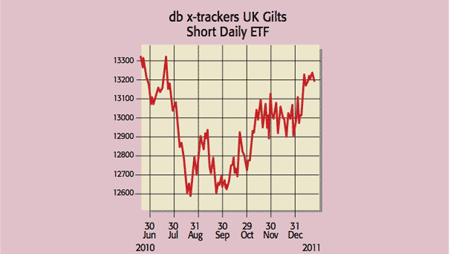
The big question for British investors in 2011 seems to be: “When are interest rates going to rise?” December’s leap in UK consumer price inflation to 3.7% has made it much tougher for the Bank of England to justify keeping the interest rate at 0.5%. The poor fourth-quarter GDP figure has muddied the waters. But markets now believe a rise is only a matter of time.
According to the short-sterling futures market, the wholesale UK interest rate (Libor, which has recently traded at a slight premium to the bank or base rate) is set to rise from 0.77% to 1.4% by the end of this year, 2.4% by the end of 2012 and 3.3% by the end of 2013. Further into the future, rates are seen plateauing at around 4%. So steady, if unspectacular, rate rises are already priced in. If you expect rates to rise further or more rapidly than this, shorting bonds may be a good bet.
Several exchange-traded funds (ETFs) allow investors to gain if rates rise. Most track indices that are tied to government bond yields. So-called short or inverse ETFs should be treated with caution: the longer you hold them, the greater the potential divergence in performance from the underlying index. Adding in double leverage (two times the underlying index performance, rebalanced daily), the scope for performance drift is much bigger.
However, for investors resident in Britain, the two funds offering short exposure to government bond markets are both offered by db x-trackers and both are based on a simple inverse return (ie minus one times the underlying bond index).
Db x-trackers’ gilts short daily ETF (LSE: XUGS) costs investors 0.25% in annual management expenses plus 0.4% in index fees. This fund allows investors to benefit if UK government bond yields rise (and thus prices fall) across the maturity spectrum. The firm’s US Treasuries short daily ETF (LSE: XUTS) is based on US government bonds of all maturities and costs the same aggregate 0.65%.
Both ETFs were launched in May last year and performed poorly for a few months, as bond yields in the US and Britain fell over the summer. Since September, both have done better as commodity price rises have boosted expectations of rate hikes. These ETFs offer an easy way to use a portion of your portfolio to protect yourself from further rises in bond yields.
• Paul Amery edits
www.indexuniverse.eu